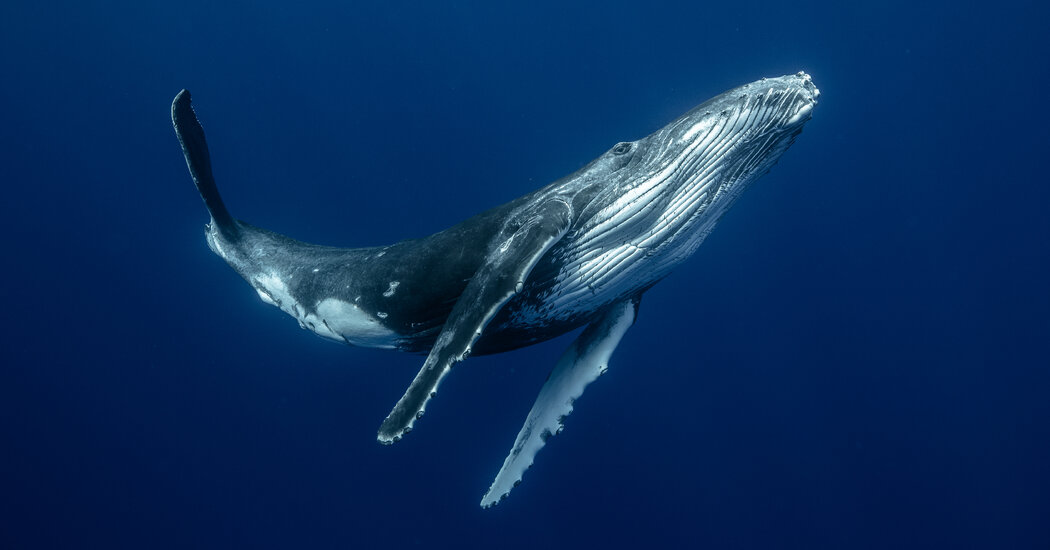People have told stories of strange underwater sounds for thousands of years, but it took until the mid-20th century for scientists to pinpoint one of the causes: whales, singing and whistling and squeaking in the blue.
The means by which some whales make these sounds has remained a mystery. A study published Wednesday in the journal Nature puts forth a new explanation, discovered thanks to a contraption that forced air through the voice boxes of three dead whales.
The voice box, or larynx, is an ancient organ. “It evolved when fish crawled out of the sea and animals needed a way to separate the air they’re breathing from the food they’re taking in,” said Coen Elemans, an author of the study and a professor of biology at the University of Southern Denmark.
The larynx functions like an antechamber to the windpipe, or trachea, with a flap of tissue called the epiglottis keeping food and drink from falling down the windpipe. A bit below the epiglottis, mammals have evolved additional folds of tissue, called vocal cords or vocal folds, which produce sounds when air exhaled from the lungs causes them to vibrate.
When the land-dwelling ancestors of whales returned to life in the sea, “they basically had to change the larynx, because when these animals are breathing on the surface, they need to expel lots of air really fast,” Dr. Elemans said. Vocal folds like those of land mammals could get in the way.
Toothed whales, like sperm whales and dolphins, use their larynges like a cork to seal their airways; they evolved a way to produce sounds in their nasal cavities instead. But scientists suspected that filter-feeding baleen whales, including the musical humpbacks and the huge blue whales, still use their voice boxes.
These whales are too large to keep in captivity and tend to do most of their vocalizing too deep underwater for divers to collect ultrasound or M.R.I. data. Instead, Dr. Elemans and his colleagues examined the next best thing: freshly preserved voice boxes dissected from three baleen whales that had died after stranding onshore, two in Denmark and one in Scotland. One was a humpback, one a minke, the last a sei.
The researchers attached the whales’ two-foot-long voice boxes to a series of pipes and pumped air through them. At first, the voice boxes failed to make any noise. But when the researchers repositioned the larynx such that a fatty pad connected to it was vibrating against the vocal folds, the lab was filled with the sounds of a vocalizing whale.
In terms of excitement among the researchers in the lab, “on a scale of one to 10, it was an 11,” said W. Tecumseh Fitch, an author of the study and a professor of cognitive biology at the University of Vienna. This means of producing sound, with air squeezed between a cushion of fat and the vocal folds, has never been seen in another animal.
Joy S. Reidenberg, a professor of anatomy at the Icahn School of Medicine at Mount Sinai who was not involved in the study, said that the experiment “changes our perspective on how sounds are made in these whales, and it perhaps shows us a mechanism which the whales might use to make more than one sound at the same time.”
She noted that the study was limited by the small number of whale voice boxes available for analysis, and that it may be fruitful to examine a greater number of specimens, especially adult male humpbacks that produce complex songs.
The researchers also created digital models to examine how constraints of lung capacity and water pressure might affect where and how the whales vocalize. The findings suggested that whales are limited to vocalizing in shallower waters. Unfortunately, this is also where noise from human activities like shipping may interfere with the vocalizations of whales.
Christopher W. Clark, a professor emeritus of neurobiology and behavior at Cornell University who was not involved with the project, said that the complexities of sound traveling underwater suggested that whales’ ability to communicate might not be quite as hampered by shipping noise as the new study suggests.
And, he said, the study offers a “road sign” indicating where researchers should focus to learn about how and where whales actually communicate with one another.







